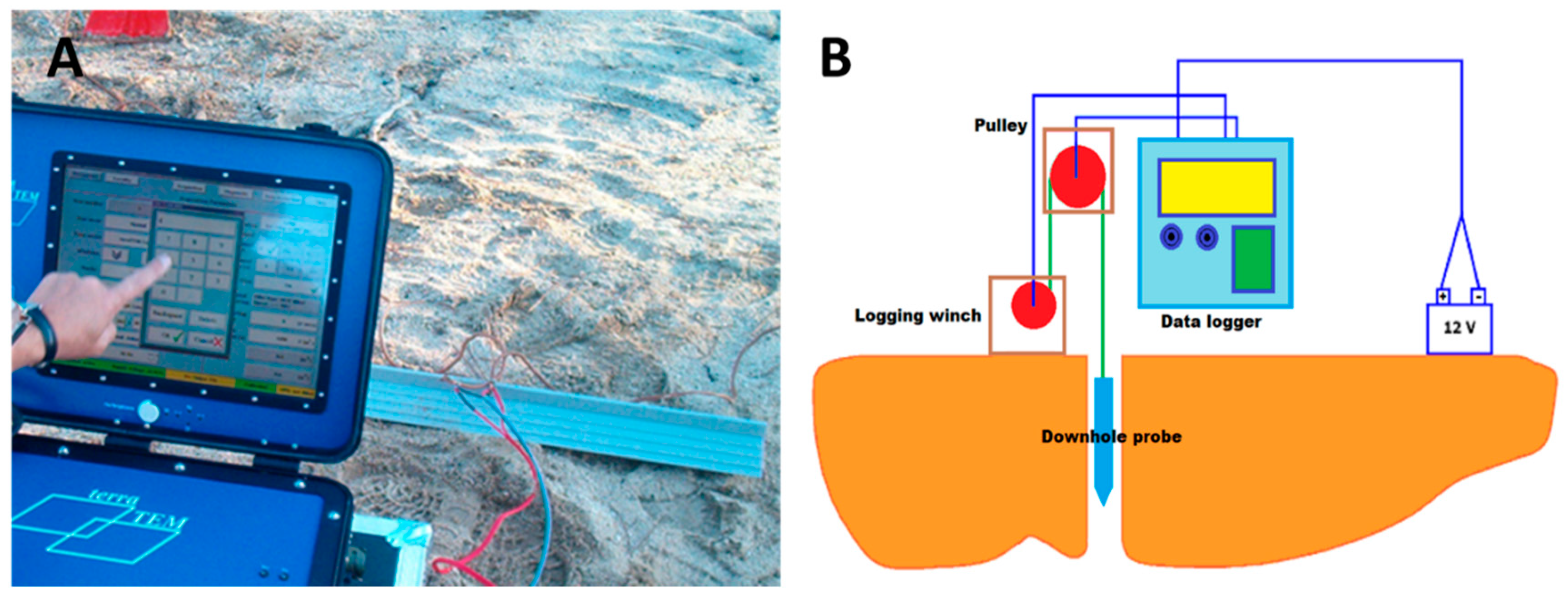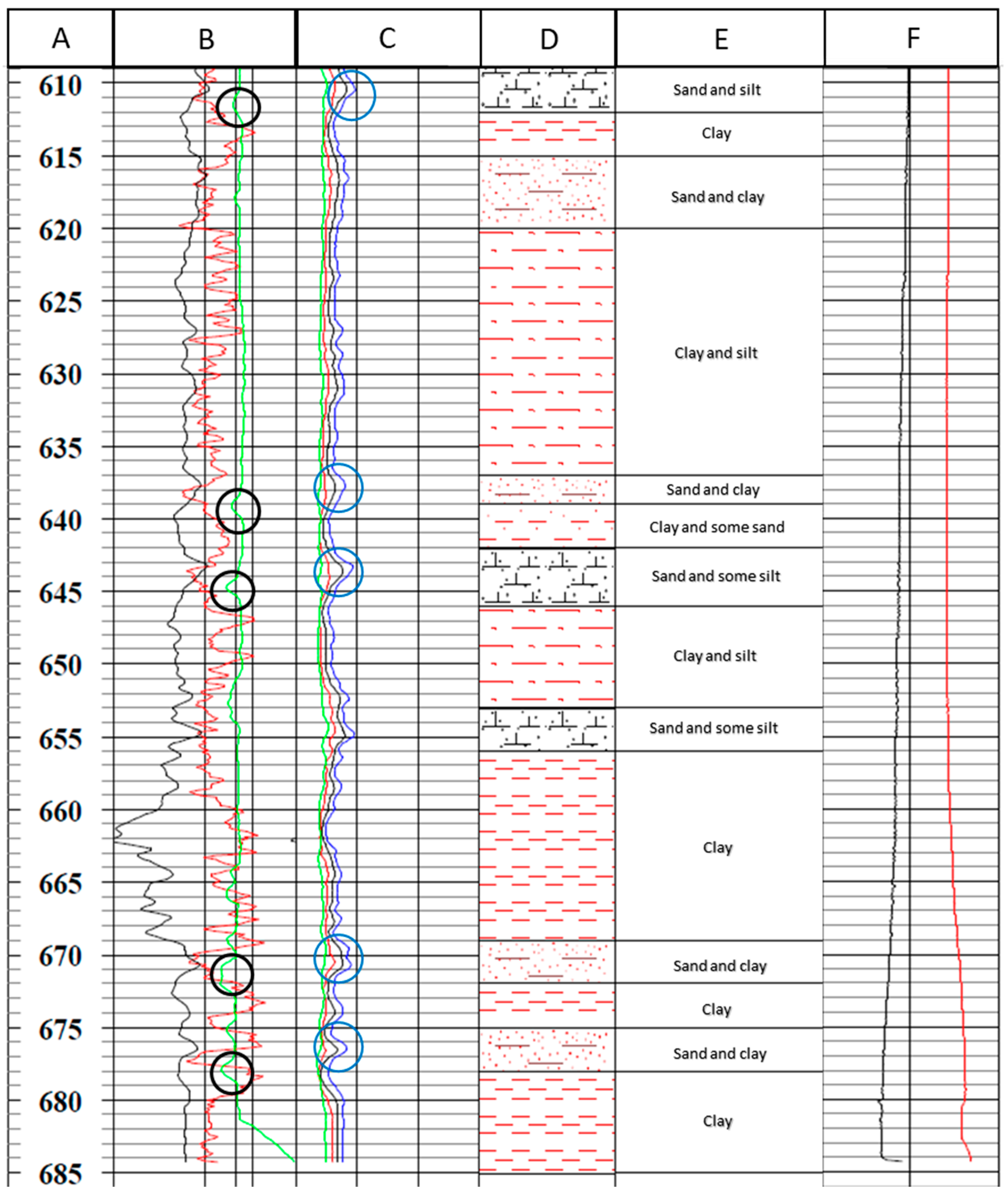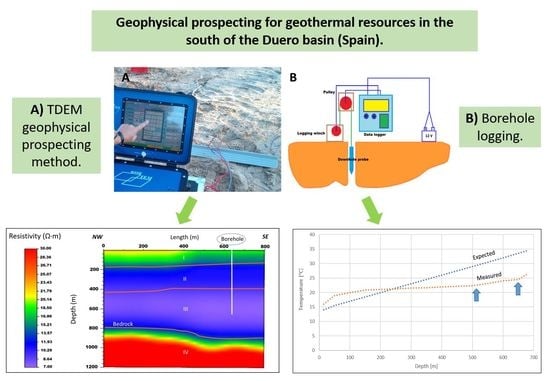Geophysical Prospecting for Geothermal Resources in the South of the Duero Basin (Spain)
Abstract
:1. Introduction
- The time domain electromagnetic (TDEM) method was used to estimate the geological structure of the sedimentary layers even beneath the length of the borehole in study. This method also revealed the depth of the bedrock in the area and how far it was from the end of the borehole logging performed. The geological information obtained with this method could be used to estimate the thermal properties of the ground to assess the performance of future geothermal systems in the location.
- Borehole logging, crossing the entire length of the sounding with a downhole probe, was able to collect data from multiple sensors that provided varied detailed information about the geological composition, traversed aquifers, temperatures throughout the borehole, etc. Additionally, from the detailed information about the geological formations crossed by the logging, it was possible to estimate the thermal properties of the ground to design well fields in geothermal systems with more detail than with the TDEM method.
2. Materials and Methods
2.1. Time Domain Electromagnetic Prospecting Methods
- The dimensions of the Tx.
- The intensity of the current flowing through the Tx.
- The duration of the transitory observation time.
- The electrical resistivity of the surface layers and of the ground in general.
2.2. Borehole Logging
2.3. Devices
2.4. Site Description
2.4.1. Geological Description of the Area
2.4.2. Hydrogeological Survey
3. Results
4. Discussion
Thermal Properties of the Ground by Geophysical Methods
5. Conclusions
Author Contributions
Funding
Acknowledgments
Conflicts of Interest
Appendix A
| Location | Thermal Water’s Chemical Composition 1 | pH 1 |
|---|---|---|
| A | Bicarbonates: 137.3 mg/L. Sulfates: 139.5 mg/L. Chlorides: 266.2 mg/L. Nitrates: 10.1 mg/L. Calcium: 116.7 mg/L. Magnesium: 26.8 mg/L. Sodium: 163.3 mg/L. Potassium: 5.9 mg/L. Silica: 18.19 mg/L. Fluorides: 0.16 mg/L. Sulfides: 0.001 mg/L. Ammonium: 0.09 mg/L. Phosphides: 0.5 mg/L. Iron: 10 µg/L. Manganese: 32 µg/L. Strontium: 1.97 mg/L. Lithium: 0.096 mg/L. | 8.51 |
| B | Bicarbonates: 307.4 mg/L. Sulfates: 757.2 mg/L. Chlorides: 3082.6 mg/L. Nitrates: 6.4 mg/L. Calcium: 26.9 mg/L. Magnesium: 9.1 mg/L. Sodium: 2189.6 mg/L. Potassium: 3.9 mg/L. Silica: 11.52 mg/L. Fluorides: 5 mg/L. Sulfides: 0.001 mg/L. Ammonium: 0.08 mg/L. Phosphides: 0.5 mg/L. Iron: 110 µg/L. Manganese: 13 µg/L. Strontium: 0.057 mg/L. Lithium: 0.145 mg/L. | 7.98 |
| C | Not available | Not available |
| D | Not available | Not available. |
| E | Bicarbonates: 236.1 mg/L. Sulfates: 12.3 mg/L. Chlorides: 34 mg/L. Nitrates: 18 mg/L. Calcium: 37.7 mg/L. Magnesium: 4.3 mg/L. Sodium: 71.8 mg/L. Potassium: 1.2 mg/L. Silica: 13.21 mg/L. Fluorides: 0.08 mg/L. Sulfides: 0.001 mg/L. Ammonium: 0.01 mg/L. Phosphides: 0.5 mg/L. Iron: 10 µg/L. Manganese: 10 µg/L. Strontium: 0.576 mg/L. Lithium: 0.053 mg/L. | 7.74 |
| F | Not available | Not available |
Appendix B







References
- Stefaniuk, M.; Maćkowski, T.; Sowiżdżał, A. Geophysical Methods in the Recognition of Geothermal Resources in Poland—Selected Examples. In Renewable Energy Sources: Engineering, Technology, Innovation; Springer: Cham, Swizerland, 2018; pp. 561–570. [Google Scholar]
- Pussak, M.; Bauer, K.; Stiller, M.; Bujakowski, W. Improved 3D seismic attribute mapping by CRS stacking instead of NMO stacking: Application to a geothermal reservoir in the Polish Basin. J. Appl. Geophys. 2014, 103, 186–198. [Google Scholar] [CrossRef]
- Isherwood, W.F.; Mabey, D.R. Evaluation of Baltazor known geothermal resources area, Nevada. Geothermics 1978, 7, 221–229. [Google Scholar] [CrossRef]
- De Giorgi, L.; Leucci, G. Study of shallow low-enthalpy geothermal resources using integrated geophysical methods. Acta Geophys. 2015, 63, 125–153. [Google Scholar] [CrossRef] [Green Version]
- Pálmason, G. Geophysical methods in geothermal exploration. In Proceedings of the 2nd UN Symposium on the Development and Use of Geothermal Resources, San Francisco, CA, USA, 20–29 May 1975; Volume 2, pp. 1175–1184. [Google Scholar]
- Wu, G.; Hu, X.; Huo, G.; Zhou, X. Geophysical exploration for geothermal resources: An application of MT and CSAMT in Jiangxia, Wuhan, China. J. Earth Sci. 2012, 23, 757–767. [Google Scholar] [CrossRef]
- Montoya, F.G.; Aguilera, M.J.; Manzano-Agugliaro, F. Renewable energy production in Spain: A review. Renew. Sustain. Energy Rev. 2014, 33, 509–531. [Google Scholar] [CrossRef]
- Banda, E.; Albert-Beltran, J.; Torné, M.; Fernàndez, M. Regional geothermal gradients and lithospheric structure in Spain. In Terrestrial Heat Flow and the Lithosphere Structure; Springer: Berlin/Heidelberg, Germany, 1991; pp. 176–186. [Google Scholar]
- Piña-Varas, P.; Ledo, J.; Queralt, P.; Marcuello, A.; Bellmunt, F.; Hidalgo, R.; Messeiller, M. 3-D magnetotelluric exploration of Tenerife geothermal system (Canary Islands, Spain). Surv. Geophys. 2014, 35, 1045–1064. [Google Scholar] [CrossRef]
- Navarro, J.Á.S.; López, P.C.; Perez-Garcia, A. Evaluation of geothermal flow at the springs in Aragon (Spain), and its relation to geologic structure. Hydrogeol. J. 2004, 12, 601–609. [Google Scholar] [CrossRef]
- EU. DIRECTIVE (EU) 2018/2001 OF THE EUROPEAN PARLIAMENT AND OF THE COUNCIL of 11 December 2018 on the Promotion of the Use of Energy from Renewable Sources. Off. J. Eur. Union 2018, 5, 82–209. [Google Scholar]
- Sáez Blázquez, C.; Farfán Martín, A.; Nieto, I.M.; González-Aguilera, D. Economic and environmental analysis of different district heating systems aided by geothermal energy. Energies 2018, 11, 1265. [Google Scholar] [CrossRef] [Green Version]
- Harvey, C.C.; Harvey, M.C. The prospectivity of hotspot volcanic islands for geothermal exploration. In Proceedings of the World Geothermal Congress 2010, Bali, Indonesia, 25–30 April 2010. [Google Scholar]
- Colmenar-Santos, A.; Folch-Calvo, M.; Rosales-Asensio, E.; Borge-Diez, D. The geothermal potential in Spain. Renew. Sustain. Energy Rev. 2016, 56, 865–886. [Google Scholar] [CrossRef]
- Chamorro, C.R.; García-Cuesta, J.L.; Mondéjar, M.E.; Linares, M.M. An estimation of the enhanced geothermal systems potential for the Iberian Peninsula. Renew. Energy 2014, 66, 1–14. [Google Scholar] [CrossRef]
- Schellschmidt, R.; Hurter, S.; Förster, A.; Huenges, E. Atlas of Geothermal Resources in Europe; Office for Official Publications of the European Communities: Brussels, Belgium, 2002. [Google Scholar]
- Mapa Hidrogeológico de España a escala 1:100.000. (Hojas 36, 37 y 38); IGME, Instituto Geológico y Minero de España: Madrid, Spain. Available online: https://info.igme.es/cartografiadigital/geologica/mapa.aspx?parent=../tematica/tematicossingulares.aspx&Id=19 (accessed on 1 July 2020).
- Harthill, N. Time-domain electromagnetic sounding. IEEE Trans. Geosci. Electron. 1976, 14, 256–260. [Google Scholar] [CrossRef]
- Rodriguez, J.C.; JC, R. Inversion of TDEM (near-zone) sounding curves with catalog interpolation. Pascal Francis 1978, 73, 57–69. [Google Scholar]
- Nabighian, M.N.; Macnae, J.C. Time domain electromagnetic prospecting methods. Electromagn. Methods Appl. Geophys. 1991, 2 Part A, 427–509. [Google Scholar]
- Munkholm, M.S.; Sørensen, K.I.; Jacobsen, B.H. Characterization and in-field suppression of noise in hydrogeophysics. In Symposium on the Application of Geophysics to Engineering and Environmental Problems; Society of Exploration Geophysicists: Tulsa, OK, USA, 1995; pp. 339–347. [Google Scholar]
- Nieto, I.M.; Martín, A.F.; Blázquez, C.S.; Aguilera, D.G.; García, P.C.; Vasco, E.F.; García, J.C. Use of 3D electrical resistivity tomography to improve the design of low enthalpy geothermal systems. Geothermics 2019, 79, 1–13. [Google Scholar] [CrossRef]
- Law, D.; Noh, K.A.M.; Rafek, A.G.M. Application of Transient Electromagnetic (TEM) Method for Delineation of Mineralized Fracture Zones. In IOP Conference Series: Earth and Environmental Science; IOP Publishing: Bristol, UK, 2019; Volume 279, p. 012038. [Google Scholar]
- Mount Sopris Instruments, Denver, CO, USA. Available online: https://mountsopris.com/ (accessed on 1 July 2020).
- Baeza Rodríguez-Caro, J.; López Geta, J.A.; Ramírez Ortega, A. Aguas Minerales y Termales de España; IGME, Instituto Geológico y Minero de España: Madrid, Spain; Chapter 6.1, ISBN: 84-7840-424-4. Available online: https://aguasmineralesytermales.igme.es/inventario-aguas-minerales-termales (accessed on 1 July 2020).
- MAGNA 50, MAPA GEOLÓGICO DE ESPAÑA 1:50.000, HOJA 481, Nava de Arévalo; IGME, Instituto Geológico y Minero de España: Madrid, Spain, 2003.
- Carreras, F.; Molina, E. Memoria de la Hoja N° 481 (Nava de Arévalo). In Mapa geológico de España E 1:50.000 (MAGNA); Segunda Serie, Primera Edición; IGME: Madrid, Spain, 1982; Depósito Legal M-29894-1982; ISSN 0373-2096. [Google Scholar]
- Aguas Minerales y Termales de España; IGME, Instituto Geológico y Minero de España: Madrid, Spain; Mapa Hidrogeológico de España a escala 1:100.000. (Hoja 37). Available online: https://info.igme.es/cartografiadigital/geologica/mapa.aspx?parent=../tematica/tematicossingulares.aspx&Id=19 (accessed on 1 July 2020).
- Ministerio de Industria. Energía y Turismo, IDAE (Instituto Para la Diversificación y Ahorro de la Energía), Manual de Geotermia; Ministerio de Industria: Madrid, Spain, 2008. [Google Scholar]
- Sáez Blázquez, C.; Carrasco García, P.; Nieto, I.M.; Maté-González, M.Á.; Martín, A.F.; González-Aguilera, D. Characterizing Geological Heterogeneities for Geothermal Purposes through Combined Geophysical Prospecting Methods. Remote Sens. 2020, 12, 1948. [Google Scholar] [CrossRef]
- Blázquez, C.S.; Martín, A.F.; García, P.C.; González-Aguilera, D. Thermal conductivity characterization of three geological formations by the implementation of geophysical methods. Geothermics 2018, 72, 101–111. [Google Scholar] [CrossRef]
- Sanner, B.; Hellström, G.; Spitler, J.; Gehlin, S. Thermal response test–current status and world-wide application. In Proceedings of the World Geothermal Congress, Antalya, Turkey, 24–29 April 2005; International Geothermal Association: Bochum, Germany, 2005; Volume 1436, p. 2005. [Google Scholar]
- Sáez Blázquez, C.; Martín Nieto, I.; Farfán Martín, A.; González-Aguilera, D.; Carrasco García, P. Comparative Analysis of Different Methodologies Used to Estimate the Ground Thermal Conductivity in Low Enthalpy Geothermal Systems. Energies 2019, 12, 1672. [Google Scholar] [CrossRef] [Green Version]










| Log | Parameter Measured | Purpose |
|---|---|---|
| Natural gamma | Natural gamma radioactivity | Lithology and the estimation of clay content (40K) |
| Fluid temperature | Temperature of borehole fluid | Geothermal gradient and water flow |
| Fluid resistivity | Resistivity of borehole fluid | Water flow and quality |
| Spontaneous potential (SP) | Electrical potentials between probe and surface electrodes | Lithology, water quality, and, in some cases, fractures in crystalline rock |
| Single point resistance (SPR) | Resistance of materials between probe and ground surface electrode | Lithology, fracture identification, and location of well screens |
| Normal resistivity | Apparent resistivity of material | Lithology and water quality |
| Sensor | Specifications 1 |
|---|---|
| Natural gamma | Natural gamma sensor composed of a sodium iodide crystal. Gamma range: 0–100,000 cps. Accuracy: 1%. Resolution: 0.02%. |
| Fluid temperature | Temperature sensor: linear and fast response semi-conductor. Range: −20–80 °C. Accuracy: 1%. Resolution: 0.4 °C. |
| Spontaneous potential (SP) | Range: −1500–1500 mV (DC). Accuracy: 1%. Resolution: 0.04%. |
| Single point resistance (SPR) | Range: 0–10,000 Ω. Accuracy: 1%. Resolution: 0.02%. |
| Resistivity (fluid and normal) | Sensors: stainless steel electrodes. Range: 0–10,000 Ω∙m. Accuracy: 1%. Resolution: 0.02%. |
| Profile Location | ||
|---|---|---|
| Latitude | Longitude | |
| A | 40°55′27.5″ N | 4°42′40.3″ W |
| B | 40°55′6.7″ N | 4°42′31.2″ W |
| Location | Description | Current Status |
|---|---|---|
| A | 20 m deep spring water drilling. Lithology sands, clays, and silts. Water temperature: 14.1 °C. | Officially declared thermal water. Spa in operation. |
| B | 234 m deep spring water drilling. Lithology clays, silts, sands, and gravel. Water temperature: 21.5 °C. | Officially declared thermal water. Spa in operation. |
| C | Historical evidence. | Dry in surface. Inactive. |
| D | Historical evidence. | Dry in surface. Inactive. |
| E | 85 m deep spring water drilling. Lithology, clays, and silts. Water temperature: 16.5 °C. | Officially declared thermal water. |
| F | Evidence. | Officially declared thermal water (in process). |
| Layer | Description | Thickness |
|---|---|---|
| I | Neogene. Sands and clays. | 120–170 m. |
| II | Neogene. Altered clays with levels of sands and silts. | ≈260 m. |
| III | Neogene. Clays and marl with levels of sands and silts. | 350–500 m. |
| IV | Early Tertiary. Sandstone, shales, and schists. | Bedrock at 800 m (NW) to 900 m (SE). |
| Column | Measurements |
|---|---|
| A | Depth (m) |
| B | Natural Gamma (0–150 counts per second) Spontaneous Potential (300–431 mV) Single point resistance (35–55 Ω) |
| C | Normal resistivity (0–30 Ω∙m; R8, R16, R32, and R64.) |
| D | Lithology (graphical description) |
| E | Lithology (description) |
| F | Fluid resistivity (214–208 Ω∙m) Temperature (10–30 °C) |
| Geophysical Method | Thermal Conductivity (W/m∙K) | Usual Deviation from TRT |
|---|---|---|
| TDEM (NW) | 1.48 | - |
| TDEM (SE) | 1.37 | - |
| Borehole Logging | 1.58 | 15% |
Publisher’s Note: MDPI stays neutral with regard to jurisdictional claims in published maps and institutional affiliations. |
© 2020 by the authors. Licensee MDPI, Basel, Switzerland. This article is an open access article distributed under the terms and conditions of the Creative Commons Attribution (CC BY) license (http://creativecommons.org/licenses/by/4.0/).
Share and Cite
Nieto, I.M.; Carrasco García, P.; Sáez Blázquez, C.; Farfán Martín, A.; González-Aguilera, D.; Carrasco García, J. Geophysical Prospecting for Geothermal Resources in the South of the Duero Basin (Spain). Energies 2020, 13, 5397. https://doi.org/10.3390/en13205397
Nieto IM, Carrasco García P, Sáez Blázquez C, Farfán Martín A, González-Aguilera D, Carrasco García J. Geophysical Prospecting for Geothermal Resources in the South of the Duero Basin (Spain). Energies. 2020; 13(20):5397. https://doi.org/10.3390/en13205397
Chicago/Turabian StyleNieto, Ignacio Martín, Pedro Carrasco García, Cristina Sáez Blázquez, Arturo Farfán Martín, Diego González-Aguilera, and Javier Carrasco García. 2020. "Geophysical Prospecting for Geothermal Resources in the South of the Duero Basin (Spain)" Energies 13, no. 20: 5397. https://doi.org/10.3390/en13205397
APA StyleNieto, I. M., Carrasco García, P., Sáez Blázquez, C., Farfán Martín, A., González-Aguilera, D., & Carrasco García, J. (2020). Geophysical Prospecting for Geothermal Resources in the South of the Duero Basin (Spain). Energies, 13(20), 5397. https://doi.org/10.3390/en13205397










